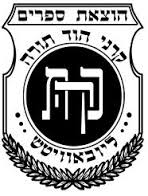“Jews have horns” is one of the oldest and oddest myths about our people. It goes back to Michelangelo’s statute of Moshes and a misinterpretation of the verse in Ki Tisa (after the story of the Golden Calf and the second tablets) that says that Moses’ face shown with radiant beams (in the Hebrew: horns) of light. It persisted until not long ago, in early America when Jewish peddlers in southern towns and cities were asked about their horns. In some rare situations, it persists even in our modern times.
 This famous horns misconception brings me to the name of Chabad’s central publishing house: Kehot. When the Rebbe Menachem Schneersohn arrived in New York in 1941, his father-in-law, then the Previous Lubavitcher Rebbe, put him in charge of three central Chabad-Lubavitch institutions, one of which is Chabad’s publishing house which he called “Kehot” or Kehos. Kehot is an acronym or acrostic for the three Hebrew words Karnei Hod Torah, emblazoned in the rounded Hebrew text atop its logo.
This famous horns misconception brings me to the name of Chabad’s central publishing house: Kehot. When the Rebbe Menachem Schneersohn arrived in New York in 1941, his father-in-law, then the Previous Lubavitcher Rebbe, put him in charge of three central Chabad-Lubavitch institutions, one of which is Chabad’s publishing house which he called “Kehot” or Kehos. Kehot is an acronym or acrostic for the three Hebrew words Karnei Hod Torah, emblazoned in the rounded Hebrew text atop its logo.
This may be obvious, but it just dawned on me this week that the words “Karnei Hod” are a reference to the glorious (see Rashi commentary) beams of light that shone from Moses’ face after coming down with the Second Tablets of the Law.
Why name a publishing house after Moses’ beaming face?
One more thing about the publishing house name. When the words are spelled out it refers to Moshe’s beaming radiance. When referred to as an acronym (as it is commonly known) as Kehot, it refers to the Kehos Levite family whose job it was to carry the Ark.
That’s interesting. Perhaps by choosing this name for the publishing house, the Rebbe was implying a two-fold mission for books, especially the type of books Kehot would print.
A) Books carry ideas. They transport ideas between people, move ideas places and span them over generations. Like the Levite family Kehos, this publishing house and its book would carry the Ark, crossing generations and continents and every type of spiritual or physical divide.
B) A good book is more than a transporter. It’s luminous, it shines, and more importantly, it makes the reader light up and shine as well. It may be hard to feel this way about many textbooks, but a really good book’s success is not in how much you learn, but in how it makes you shine with its light.
So the horns reference is mistaken and archaic, but the shining radiance idea is not. It remains a challenge and opportunity for us, to read and learn Torah in such a way that it illuminates us, that helps us shine, and bring light to our world.
